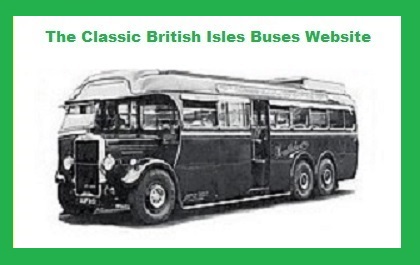

The Classic British Isles Buses Website
Transport in India in 2006: page 1 - general transport (by Dick Gilbert)
Last updated 28 August 2024
Email Events diary Past events list Classified adverts Classic U.K. Buses Classic Irish Buses Classic Manx Buses
It was a huge pleasure to spend a short holiday in India in October 2006. What a fantastic country! We visited four states - Delhi (DL registrations), Haryana (HR), Uttar Pradesh (UP) and Rajasthan (RJ), and the following three pages are a personal view of what I saw in the way of transport, divided into the sections listed above:
I expected to find some remnants of the country's British-connected past, but was surprised to learn that virtually all traces had gone. More or less every vehicle in India (or certainly in the parts we visited) is now of Indian manufacture, and the only nods towards the old colonial occupier were a few Royal Enfield motorcycles and Massey Ferguson tractors, all of which are made locally. I hoped to see a Morris Minor, at least, but came across no such thing. Presumably all old British vehicles had been recycled a long time ago. There was however a common car named the Ambassador, which apparently has British ancestry - more of that later.
So let's start at the lower end of the transport scale - the bicycle - which commonly come with two wheels or three, as this scene in Old Delhi shows.

The three wheeler, whether driven by pedal or motor, is immensely popular in India, as is used for personal transport, as a rickshaw, and for the carriage of goods. Overloading is an essential art on all vehicles, and the bicycle is no exception. Here are a couple of examples seen in Jaipur.


The next step up the ladder is animal power. All sorts of animals are used, but most often this is done by donkey.....
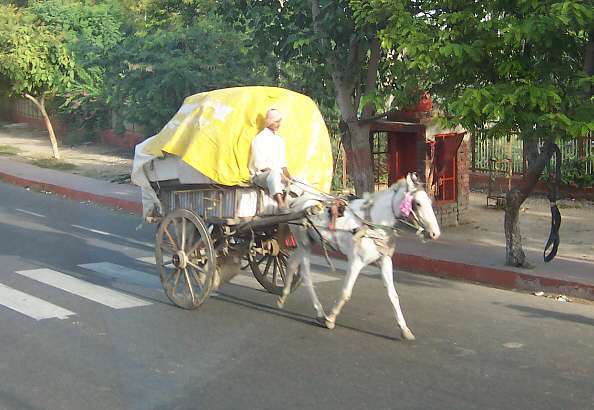
..... or bullock......

.....or camel.

With regard to the above picture I would like to draw your attention to the wheels. According to our local tour guide, these wheels and tyres have been transplanted from aircraft. They are certainly not modern, and look to me as though they might date back to the 1930s or 1940s, perhaps from World War II aircraft. That would make the wheels antiques in their own right, and they might even be of interest to vintage aircraft restorers, if only one could figure out what type of aircraft they came from ! Here are some more examples:


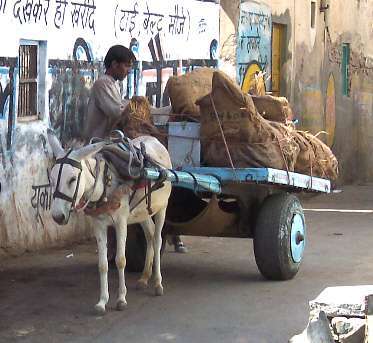
Possible pieces of history there, all seen in Rajasthan.
To move on to motorized vehicles, one cannot consider Indian transport without mentioning the tricycle auto rickshaw or tri-shaw, commonly known in many countries as the tuk-tuk. In fact that phrase normally refers to the passenger carrying examples, but the three-wheel configuration turns up in various goods vehicles as well. Below is the Piaggio Ape, the most common type of tuk-tuk in Delhi.
David Hope emailed to point out that tuk-tuk is actually the Thai nickname for these 3-wheeled vehicles. Their correct name in Thai is samlor (= 3 wheels) and in India they are called autos, short for autorickshaws.

Other tuk-tuk manufacturers include Bajaj, Greaves and, as seen below, Kerala Automobile, whose diesel 360R and 400R vehicles were very common in Rajasthan. These examples are seen in Kuchaman.
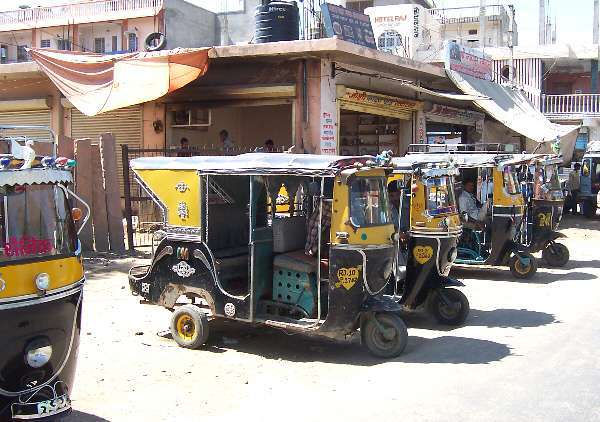
Goods tricycles include the Minidor, Mahindra (who also make jeeps), Maruti, and Atul, whose Shakti model is shown below at Ajmer railway station. Motor cycles tend to be licence-built foreign designs, apart from the local firm TVS, and Royal Enfield (mentioned above). Suzuki, Kawasaki and Honda - marketed as Hero Honda - represent the majority to be seen.

Cars are modern, mostly made locally (such as Tata and Maruti), but a few Japanese imports were also spotted, including Suzuki, Honda and Hyundai, although I suppose these too may have been built in India under licence. Mention must be made, however, of the Ambassador, made by Hindustan Motors in Bengal. The design dates from 1948 and was based on the Morris Oxford, although it has been hugely updated since then, and now comes with the option of petrol, diesel or LPG engines. Available apparently in a variety of colours, although white seemed to be most common, the standard version is the Ambassador Classic, and top of the range is the Ambassador Grand, 2000dsz Turbo (featuring rear stoplights!).
David Hope emailed to say "As far as I am aware, the Ambassador car is based on the Series II Morris Oxford, which dates from around 1956. You mentioned 1948 for its origins, but I would guess that that is too early, the Morris Oxford of that date was essentially an overgrown Minor, and the later and larger body dates from the 50s. The dished bonnet marked out the Series II version."
See the Ambassador website for more information http://www.hmambassador.com/. Here are a couple of Classics seen in Agra.
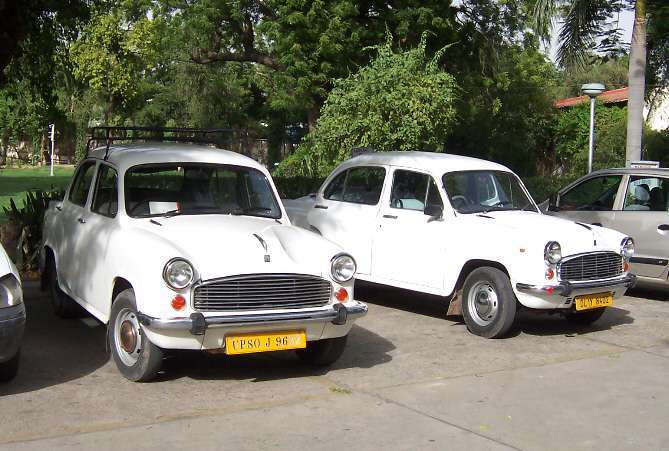
A brief word about registration numbers. The first two letters represent the state (in this case UP for Uttar Pradesh and DL for Delhi), the next number is the city code (UP 80 is Agra, DL 1 is Delhi city), followed by a letter/ number combination unique to the actual vehicle. Yellow plates with black lettering are for commercial vehicles (taxis, trucks, buses etc.), privately-owned vehicles have white plates with black letters, and trade plates have red letters on a yellow background.
Email Events diary Past events list Classified adverts Classic U.K. Buses Classic Irish Buses Classic Manx Buses